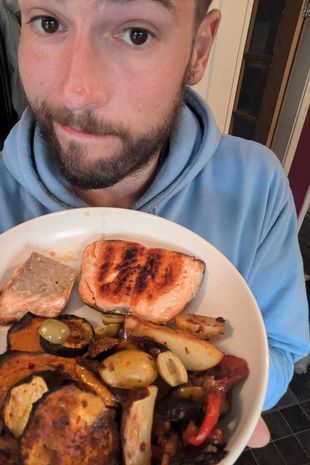The Mediterranean diet is taking the internet by storm, with enthusiasts claiming it’s a game-changer for weight loss and diabetes prevention.
Originating from the culinary traditions of Mediterranean countries in the mid-20th century, this diet emphasizes cutting down on refined sugars and increasing plant-based food intake. It means loading up on vegetables, fruits, beans, nuts, whole grains, and opting for healthy fats like olive oil.
Fish is a major staple of the Mediterranean diet, while poultry, dairy, and eggs are to be consumed moderately, a few times a week. Red meat is allowed, but only as an occasional treat, keeping the diet flexible rather than strict.
Journalist Matt Jackson, 32, said he was keen to lose a few pounds and decided to trial the diet for a week, but quickly it required a little more planning than his regular diet. He said: “With my plan formulated, it was off to the shops, armed with a list and a sense of intrigue. I soon however hit a stumbling block.

(
Reach)
“I’d picked my meals with enthusiasm, jotted down the ingredients, and then not actually considered how readily available they’d be in my small Cheshire town.
“How hard can edamame beans be to find? An ingredient on my first meal of the week – Salmon and Mediterranean veg. As it turned out, they were a step too far, and having visited three different supermarkets, I abandoned hope, and just substituted them for something else on my list.”
Matt opted for cinnamon roll overnight oats as his breakfast for the week, which he cleverly batch-prepared in advance. He said: “Enjoyably straight forward, made by chucking your oats portion, fat-free Greek yoghurt, cinnamon, vanilla essence, and oat milk into a container then mix together before popping in the fridge overnight.”
He also meal prepped his lunch, which contained majority vegetables. He said: “I did manage to batch-prepare some lunches. I opted for a “super food salad” consisting mostly of grains – quinoa – kale, lettuce, beans, and sliced chicken for the protein boost at lunch.

(
Reach)
“Having something I could just grab out of the fridge at lunch time was simple and fantastic. Even as someone who spends a large portion of their life working from home, you still don’t want to stand at the fridge scratching your head come lunch time.”
It meant Matt’s evening meals could consist of a fish-based dish – often with plenty of vegetables – with the occasional wholemeal pasta accompaniment. Soon enough, he was shedding the pounds.
Matt said: “Overall, it went smoothly. Despite not having firm expectations, there was a part of me hoping to see the scales tip down by a few pounds.
“To my astonishment, I discovered that I had lost 3.4kg (7.5lb) by the end of the week. While it’s common to see a significant drop when you first overhaul your diet, this was more than I anticipated – particularly as I believed my diet was fairly healthy for the most part.”
Sharing his key takeaways from the trial week, Matt said: “Preparing meals at breakfast time significantly eased the start of the day, incorporating a wholesome, natural snack and water curbed the craving for “ultra-processed” soft drinks, and making lunch eliminated the temptation to ‘pop to the shop’ for a pre-packaged sandwich when there was ‘nothing in’.”

(
Reach)
Matt’s daily meal plan on the Mediterranean diet was as follows.
- Breakfast – Cinnamon roll overnight oats with walnuts and blackberries – 453 cal.
- Morning snack – pear and an easy peeler – 104 calories.
- For lunch, a chicken super food salad is on the menu, clocking in at 546 calories.
- Dinner consists of roasted salmon and vegetables, totalling 422 calories.
- The total calorie count for the day is 1,525.
The NHS advises those looking to shed pounds to follow a balanced diet, which includes consuming five portions of fruit and vegetables each day.
The Department of Nutrition and Dietetics also highlights numerous benefits associated with adhering to a Mediterranean diet.
Source: bing.com




















